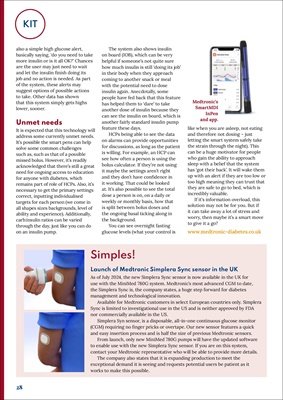
28KIT
also a simple high glucose alert,
basically saying, 'do you need to take
more insulin or is it all OK?' Chances
are the user may just need to wait
and let the insulin finish doing its
job and no action is needed. As part
of the system, these alerts may
suggest options of possible actions
to take. Other data has shown
that this system simply gets highs
lower, sooner.
Unmet needs
It is expected that this technology will
address some currently unmet needs.
It's possible the smart pens can help
solve some common challenges
such as, such as that of a possible
missed bolus. However, it's readily
acknowledged that there's still a great
need for ongoing access to education
for anyone with diabetes, which
remains part of role of HCPs. Also, it's
necessary to get the primary settings
correct, inputting individualised
targets for each person (we come in
all shapes sizes backgrounds, level of
ability and experience). Additionally,
carb:insulin ratios can be varied
through the day, just like you can do
on an insulin pump.
Simples!
Launch of Medtronic Simplera Sync sensor in the UK
As of July 2024, the new Simplera Sync sensor is now available in the UK for
use with the MiniMed 780G system. Medtronic's most advanced CGM to date,
the Simplera Sync is, the company states, a huge step forward for diabetes
management and technological innovation.
Available for Medtronic customers in select European countries only. Simplera
Sync is limited to investigational use in the US and is neither approved by FDA
nor commercially available in the US.
Simplera Syn sensor, is a disposable, all-in-one continuous glucose monitor
(CGM) requiring no finger pricks or overtape. Our new sensor features a quick
and easy insertion process and is half the size of previous Medtronic sensors.
From launch, only new MiniMed 780G pumps will have the updated software
to enable use with the new Simplera Sync sensor. If you are on this system,
contact your Medtronic representative who will be able to provide more details.
The company also states that it is expanding production to meet the
exceptional demand it is seeing and requests potential users be patient as it
works to make this possible.
The system also shows insulin
on board (IOB), which can be very
helpful if someone's not quite sure
how much insulin is still 'doing its job'
in their body when they approach
coming to another snack or meal
with the potential need to dose
insulin again. Anecdotally, some
people have fed back that this feature
has helped them to 'dare' to take
another dose of insulin because they
can see the insulin on board, which is
another fairly standard insulin pump
feature these days.
HCPs being able to see the data
on alarms can provide opportunities
for discussions, as long as the patient
is willing. For example, an HCP can
see how often a person is using the
bolus calculator. If they're not using
it maybe the settings aren't right
and they don't have confidence in
it working. That could be looked
at. It's also possible to see the total
dose a person is on, on a daily or
weekly or monthly basis, how that
is split between bolus doses and
the ongoing basal ticking along in
the background.
You can see overnight fasting
glucose levels (what your control is
like when you are asleep, not eating
and therefore not dosing - just
letting the smart system safely take
the strain through the night). This
can be a huge motivator for people
who gain the ability to approach
sleep with a belief that the system
has 'got their back'. It will wake them
up with an alert if they are too low or
too high meaning they can trust that
they are safe to go to bed, which is
incredibly valuable.
If it's information overload, this
solution may not be for you. But if
it can take away a lot of stress and
worry, then maybe it's a smart move
to give it a go?
Caption.